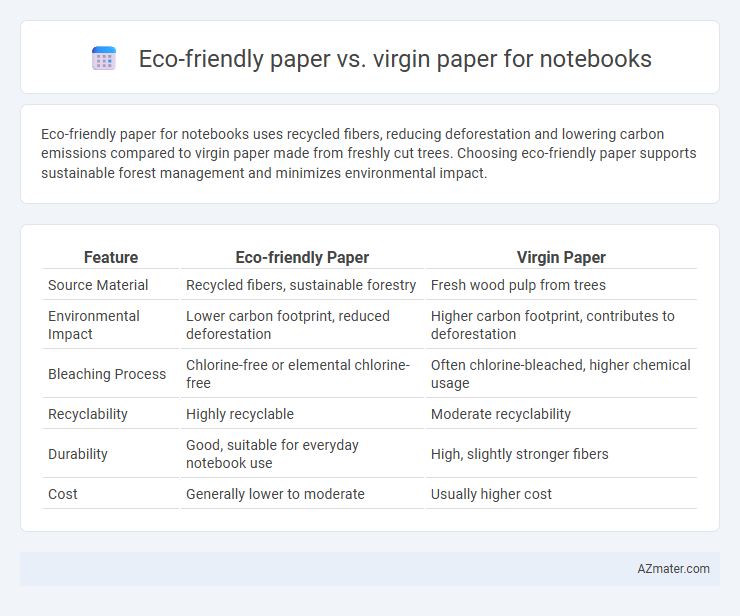Eco-friendly paper for notebooks uses recycled fibers, reducing deforestation and lowering carbon emissions compared to virgin paper made from freshly cut trees. Choosing eco-friendly paper supports sustainable forest management and minimizes environmental impact.
Table of Comparison
| Feature | Eco-friendly Paper | Virgin Paper |
|---|---|---|
| Source Material | Recycled fibers, sustainable forestry | Fresh wood pulp from trees |
| Environmental Impact | Lower carbon footprint, reduced deforestation | Higher carbon footprint, contributes to deforestation |
| Bleaching Process | Chlorine-free or elemental chlorine-free | Often chlorine-bleached, higher chemical usage |
| Recyclability | Highly recyclable | Moderate recyclability |
| Durability | Good, suitable for everyday notebook use | High, slightly stronger fibers |
| Cost | Generally lower to moderate | Usually higher cost |
Introduction to Eco-Friendly vs Virgin Paper
Eco-friendly paper for notebooks is produced using recycled fibers or sustainable raw materials, reducing environmental impact by conserving trees and lowering energy consumption. Virgin paper is made from freshly harvested wood pulp, resulting in higher brightness and strength but a greater carbon footprint due to deforestation and intensive processing. Choosing eco-friendly paper supports sustainable forestry practices and decreases waste, aligning with environmentally conscious consumer preferences.
What is Eco-Friendly Paper?
Eco-friendly paper is produced using recycled fibers, sustainably sourced materials, or alternative raw materials that reduce environmental impact compared to virgin paper, which is made from freshly harvested trees. It minimizes deforestation, lowers carbon emissions, and reduces water and energy consumption during production. Choosing eco-friendly paper for notebooks supports sustainable forestry practices and promotes waste reduction through fiber recycling.
Understanding Virgin Paper
Virgin paper, made from freshly harvested wood fibers, offers superior strength, durability, and a smooth texture ideal for high-quality notebooks. It undergoes less recycling processing, reducing ink absorption and enhancing print clarity, making it preferred for premium stationery. However, its production demands significant natural resources and energy, impacting environmental sustainability compared to eco-friendly alternatives.
Environmental Impact Comparison
Eco-friendly paper for notebooks significantly reduces environmental impact by utilizing recycled fibers and sustainable resources, leading to lower deforestation rates and decreased greenhouse gas emissions compared to virgin paper. Virgin paper production demands higher energy consumption and water usage, contributing to habitat destruction and increased carbon footprint. Choosing eco-friendly paper supports conservation efforts and promotes a circular economy by minimizing waste and preserving natural ecosystems.
Resource Consumption and Sustainability
Eco-friendly paper for notebooks significantly reduces resource consumption by utilizing recycled fibers, minimizing deforestation and water usage compared to virgin paper made from freshly harvested trees. Virgin paper production demands extensive energy and raw materials, contributing to higher carbon emissions and environmental degradation. Choosing eco-friendly paper supports sustainability by promoting circular economy practices and lowering the ecological footprint of notebook manufacturing.
Benefits of Eco-Friendly Paper for Notebooks
Eco-friendly paper for notebooks reduces deforestation by utilizing recycled fibers and sustainable sourcing, minimizing environmental impact and conserving natural resources. It often requires less energy and water during production compared to virgin paper, leading to lower carbon emissions and a smaller ecological footprint. Using eco-friendly paper supports a circular economy and promotes responsible consumption, appealing to environmentally conscious consumers and enhancing brand reputation.
Drawbacks of Virgin Paper in Notebook Production
Virgin paper used in notebook production requires extensive deforestation, leading to significant environmental degradation and loss of biodiversity. The high energy consumption and chemical processes involved in manufacturing virgin paper contribute to greater carbon emissions and water pollution compared to eco-friendly alternatives. Additionally, virgin paper production often results in less sustainable waste management and lower recyclability, increasing the ecological footprint of notebooks made from this material.
Quality and Performance Differences
Eco-friendly paper for notebooks often incorporates recycled fibers, resulting in a slightly rougher texture and less brightness compared to virgin paper, which is made from fresh wood pulp and typically offers smoother surfaces and more vibrant colors. Virgin paper generally provides superior strength and durability, making it ideal for long-lasting notebooks, while eco-friendly paper may show reduced tear resistance and ink absorption quality. Performance differences include the tendency for virgin paper to handle high-quality printing and writing instruments better, whereas eco-friendly options prioritize sustainability with a minor compromise in tactile and visual consistency.
Cost Analysis: Eco-Friendly vs Virgin Paper
Eco-friendly paper for notebooks typically offers cost advantages due to its use of recycled fibers, reducing raw material expenses and energy consumption during production. Virgin paper, made from fresh wood pulp, often incurs higher costs related to deforestation impacts, processing energy, and supply chain sustainability measures. Price variations also depend on factors like paper quality, printing requirements, and regional availability, influencing the overall cost-effectiveness of eco-friendly versus virgin paper in notebook manufacturing.
Making the Sustainable Choice for Notebooks
Eco-friendly paper for notebooks is made from recycled fibers or sustainable sources, reducing deforestation and conserving natural resources compared to virgin paper derived from newly harvested trees. This sustainable choice lowers carbon footprints and minimizes waste, supporting environmental conservation efforts. Selecting eco-friendly paper not only promotes responsible forestry but also aligns with growing consumer demand for greener stationery products.

Infographic: Eco-friendly paper vs Virgin paper for Notebook
 azmater.com
azmater.com